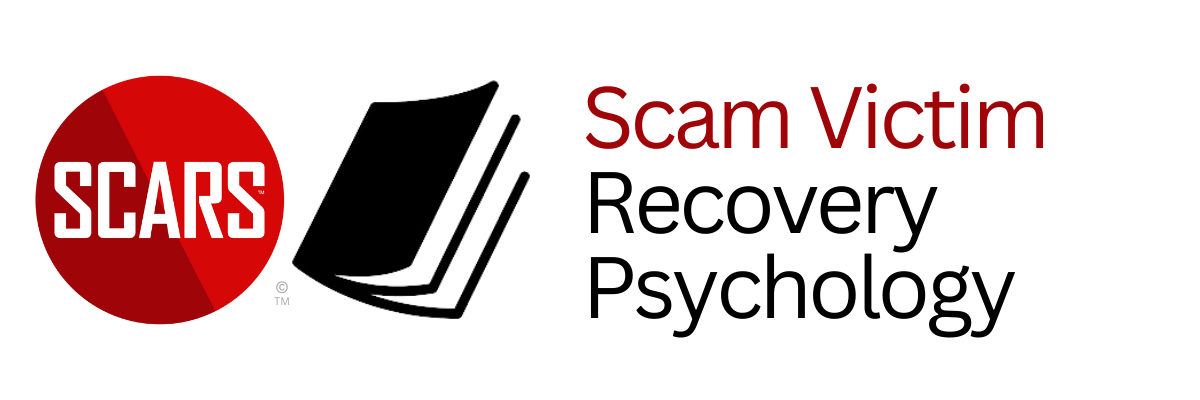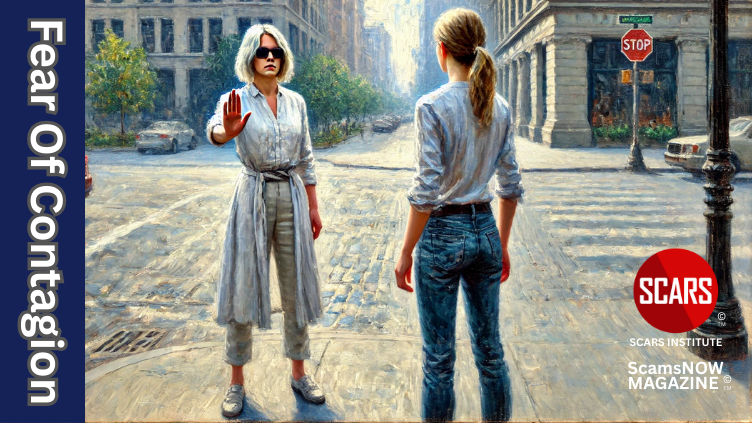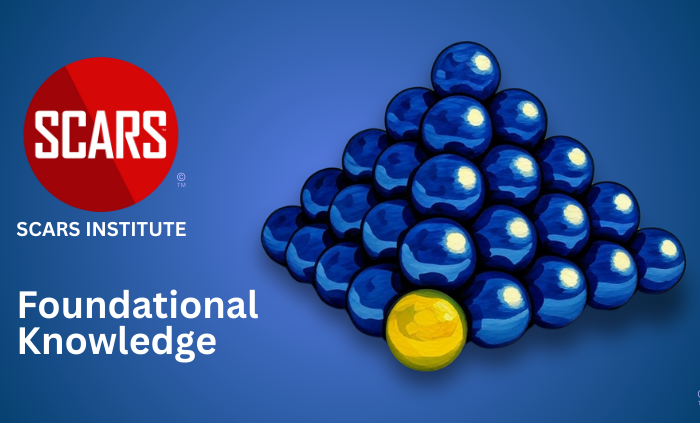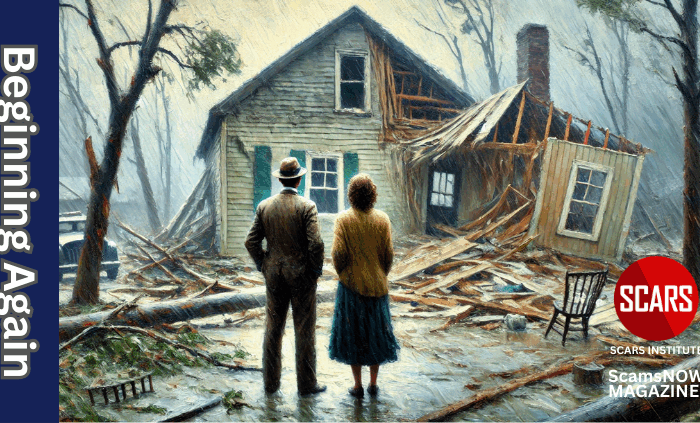Fear Of Contagion: Why Scam Victims Are Harshly Judged And Blamed
Helping Both Victims and Families or Friends to Better Understand
Author:
• Vianey Gonzalez – Licensed Psychologist Specialty in Crime Victim Trauma Therapy, Neuropsychologist, Certified Deception Professional, Psychology Advisory Panel & Director of the Society of Citizens Against Relationship Scams Inc.
• Tim McGuinness, Ph.D. – Anthropologist, Scientist, Director of the Society of Citizens Against Relationship Scams Inc.
About This Article
Fear of contagion is a hidden psychological response that deeply affects how nonvictims treat scam victims after a crime. Driven by a denial of vulnerability, projection of personal anxieties, a desire to regain control, and societal stigma, this fear causes nonvictims to distance themselves emotionally, blame the victim, and react with judgment or rejection. When people encounter a crime victim, it forces them to confront the unsettling reality of their own fragility, leading to unconscious defense mechanisms that isolate and marginalize the victim further.
Victims are often viewed as “the other,” subjected to labels, minimized experiences, and social distancing. These reactions compound the victim’s trauma and delay recovery by reinforcing feelings of shame, isolation, and mistrust. Overcoming the fear of contagion requires self-reflection, acknowledgment of shared human vulnerability, the development of empathy, and cultural shifts that reject victim-blaming narratives. By confronting this fear honestly and choosing compassion over judgment, society can offer genuine support to crime victims and foster a more just, humane environment where healing and understanding replace fear and rejection.

Fear Of Contagion – The Hidden Fear of Crime Victims: How Nonvictims Engage In Denial, Projection, And Extreme Judgmentalism Against Scam Victims
After a scam, victims experience a unique reaction based in the fear of contamination!
This article is intended to help scam victims to better understand this ‘Fear of Contagion’ and why they are treated negatively, and also perhaps to help their family and friends to understand why they are treated differently after the crime occurs.
In the aftermath of a crime, victims often face a barrage of questions and judgments. Their experiences are scrutinized, their choices dissected, and their actions evaluated. Amidst this whirlwind of scrutiny, a subtle yet pervasive sentiment emerges as the fear of contagion.
This fear is not openly expressed, but it lingers beneath the surface, a silent dread that the victim’s misfortune could somehow seep into their own lives. It manifests in dismissive remarks, victim-blaming statements, and an undercurrent of unease when interacting with those who have been touched by crime.
Where does the Fear of Contagion come from?
The fear of contagion stems from a deep-seated human instinct for self-preservation but also from the observer’s impotence over not being able to provide meaningful help to the victim.
We seek to maintain a sense of control over our lives, to believe that we are somehow immune to the misfortunes that befall others. By distancing ourselves from victims and minimizing their experiences, we create a psychological barrier, a shield against the possibility that it could happen to us.
This denial, however, serves only to further isolate and alienate victims. It reinforces their sense of isolation and compounds their trauma. Instead of offering support and understanding, we inadvertently push them further into the margins, perpetuating a cycle of victimization.
To overcome this fear of contagion, we must first acknowledge its existence. We must recognize that the fear is not a reflection of the victims, but rather a projection of our own anxieties. It is a manifestation of our deepest fears, a fear of the unknown, the uncontrollable, the fragility of our own safety.
Once we acknowledge this fear, we can begin to dismantle it. We can confront the reality that crime can happen to anyone, regardless of their background, their choices, or their precautions. We can recognize that victims are not to blame for their experiences but rather are the unfortunate recipients of circumstances beyond their control.
By acknowledging and confronting our fear of contagion, we can open ourselves to empathy and understanding. We can offer support and compassion to those who have been victimized, creating a society that is not only safer but also more humane.
That Deep Fear of Contagion
The fear of contagion, in the context of crime victims, stems from a complex interplay of psychological factors, including:
Denial of Vulnerability: Humans possess a natural tendency to deny their own vulnerability to negative events. We construct mental barriers that shield us from the uncomfortable reality that we are not immune to misfortune. When confronted with crime victims, this denial mechanism kicks in, leading us to believe that we are somehow different and that we would never make the same “mistakes” that led to their victimization.
Projection of Anxiety: The fear of contagion is often a projection of our own anxieties and insecurities. We fear the possibility of becoming victims ourselves, and this fear manifests in a tendency to distance ourselves from those who have already experienced crime. By minimizing their experiences and blaming them for their victimization, we create a sense of separation, making ourselves feel less vulnerable.
Impotence and Inability to Help: Often people feel impotent to help after serious harm has been done to someone they care about. Our natural desire is to make things right. Yet the feeling can manifest both in frustration and fear, and results in potentially harmful reactions against victims.
Threat to Sense of Control: Crime disrupts our sense of control over our lives. It shatters the illusion that we are safe and in command of our surroundings. When we encounter crime victims, it reminds us of our own fragility, our own potential to be victims. This loss of control triggers a fear response, leading us to distance ourselves from the victims and their experiences.
Lack of Empathy: Empathy is the ability to understand and share the feelings of others. When we lack empathy, we struggle to connect with crime victims on an emotional level. This lack of connection makes it easier for us to dismiss their experiences, blame them for their victimization, and maintain a sense of separation.
Societal Stigma: Crime victims often face stigma and prejudice, both from individuals and from society as a whole. This stigma reinforces the fear of contagion, making it more difficult for victims to find support and understanding. It also contributes to a culture of victim-blaming, further isolating and marginalizing those who have been victimized.
Much of this also stems from a change in the perception of the victims. In effect, they become ‘The Other’ and are then viewed as separate and different.
Denial of Vulnerability
Denial of vulnerability, in the context of crime victims, is a psychological defense mechanism that prevents individuals from acknowledging their own susceptibility to crime. It manifests as a belief that “it could never happen to me,” often accompanied by a tendency to distance oneself from crime victims and minimize their experiences.
This denial serves several purposes:
Preserves a Sense of Safety: By denying our vulnerability, we maintain an illusion of control over our lives, reducing the anxiety associated with the possibility of becoming a victim ourselves.
Avoids Emotional Discomfort: Confronting our vulnerability can be emotionally unsettling, forcing us to grapple with the harsh realities of crime and our own potential victimization. Denial provides a psychological buffer, shielding us from this discomfort.
Maintains Self-Esteem: Acknowledging our vulnerability can challenge our self-perception of competence and resilience. Denial allows us to uphold a positive self-image, protecting our self-esteem from the potential blow of admitting our own susceptibility.
However, denial of vulnerability comes at a cost. It prevents us from developing genuine empathy for crime victims, fostering a culture of victim-blaming and isolation. It also hinders our ability to address the root causes of crime effectively, as we fail to recognize our own shared vulnerability and the collective responsibility we have to create a safer society.
To overcome denial of vulnerability, we must engage in a process of self-reflection and introspection:
Acknowledge Our Shared Humanity: We are all human, and as such, we are all susceptible to misfortune, including crime. Recognizing our shared vulnerability is the first step toward empathy and understanding.
Challenge Our Assumptions: Our assumptions about our own safety may be based on privilege or luck, not on any inherent immunity to crime. Critically examining these assumptions can help us confront our denial.
Listen to Crime Victims: Engaging with crime victims’ stories, without judgment or minimization, can help us understand their experiences and the impact of crime on their lives.
Support Victims’ Rights: Advocating for the rights and well-being of crime victims demonstrates our commitment to creating a society that values compassion and support for those who have been victimized.
By confronting our denial of vulnerability, we can foster a more just and compassionate society, one that acknowledges the shared human experience of vulnerability and extends support to those who have been touched by crime.
Projection of Anxiety
Projection of anxiety, in the context of crime victims, is a psychological defense mechanism in which individuals unconsciously transfer their own anxieties and fears about crime onto the victims themselves. This projection manifests in various ways, including:
Victim-blaming: By attributing the victim’s misfortune to their own actions or choices, individuals deflect their own anxiety about becoming victims. They construct a narrative of victim culpability, suggesting that the victim could have avoided their fate through better decision-making.
Minimizing the victims’ experiences: Downplaying the severity or impact of the crime on the victim serves to reduce the perceived threat to the individual’s own safety. By dismissing the victim’s pain and suffering, they distance themselves from the reality of crime and maintain a sense of control.
Social distancing: Avoiding close contact with crime victims creates a psychological barrier, shielding the individual from emotional discomfort and the potential threat of contagion. This distancing reinforces the isolation of the victims and perpetuates the cycle of victimization.
Hypervigilance: Individuals may become excessively vigilant in their own lives, adopting extreme measures to avoid potential victimization. This hypervigilance is fueled by the projected anxiety, leading to an exaggerated perception of personal risk.
Denial of own vulnerability: Underlying the projection of anxiety is often a denial of one’s own vulnerability to crime. By focusing on the perceived shortcomings of the victim, individuals avoid confronting their own susceptibility.
Overcoming the projection of anxiety requires a conscious effort to recognize and address the underlying anxieties:
Acknowledge Personal Anxieties: Reflecting on personal fears and concerns about crime can help individuals identify the root causes of their projection. Understanding the underlying anxieties can facilitate a more empathetic approach to crime victims.
Develop Emotional Regulation Skills: Effective emotional regulation skills, such as mindfulness and relaxation techniques, can help individuals manage their anxieties in a healthy way, reducing the need for projection.
Empathy Cultivation: Engaging in practices that promote empathy, such as perspective-taking and active listening, can help individuals connect with crime victims on an emotional level, fostering understanding and compassion.
Seek Professional Help: If anxieties about crime are severe or interfere with daily life, seeking professional help from a therapist or counselor can provide valuable support and guidance.
By acknowledging and addressing the projection of anxiety, individuals can develop a more compassionate and empathetic response to crime victims, creating a more supportive and just society.
Impotency and the Inability to Help
Impotency and the inability to help crime victims can trigger a range of harmful reactions, including judgmentalism and victim-blaming. These reactions often stem from a sense of helplessness, frustration, and a desire to regain control in the face of a traumatic event.
Judgmentalism
Judgmentalism arises from a tendency to place blame or responsibility on the victim for the crime they have endured. This can manifest in various ways, such as:
Questioning the victim’s actions or decisions: Individuals may scrutinize the victim’s choices, suggesting that they could have avoided the crime had they acted differently.
Labeling the victim: Labels like “careless,” “naive,” or “irresponsible” can be attached to the victim, implying that their actions contributed to their victimization.
Minimizing the victim’s experience: The severity of the crime and the impact on the victim may be downplayed, suggesting that the victim is overreacting or exaggerating their distress.
Judgmentalism not only fails to acknowledge the trauma experienced by the victim but also compounds their suffering. It creates an atmosphere of isolation and disbelief, further marginalizing the victim and hindering their healing process.
Victim-Blaming
Victim-blaming directly attributes the crime to the victim’s actions or character, shifting the responsibility away from the perpetrator. This can manifest in various ways, such as:
Suggesting the victim deserved it: Individuals may imply that the victim’s behavior, lifestyle, or past actions made them a target, justifying the crime.
Shifting responsibility: The victim is held responsible for the perpetrator’s actions, suggesting that they could have controlled or prevented the crime if they had acted differently.
Promoting stereotypes: Preconceived notions about certain groups or lifestyles may be used to justify the victimization, perpetuating harmful stereotypes and prejudices.
Victim blaming not only compounds the victim’s trauma but also undermines the pursuit of justice. It excuses the perpetrator’s actions and discourages victims from coming forward, ultimately contributing to a cycle of impunity.
Addressing Harmful Reactions
To combat judgmentalism and victim-blaming in non-victims, it is crucial to promote empathy, understanding, and a victim-centered approach:
Empathy Cultivation: Encourage individuals to put themselves in the victim’s shoes, considering their emotions, experiences, and perspectives.
Education and Awareness: Raise awareness about the impact of crime on victims, challenging victim-blaming stereotypes and promoting a culture of compassion.
Support for Victims: Create supportive environments where victims feel safe to come forward, seek help, and navigate the aftermath of crime without fear of judgment or blame.
Accountability for Perpetrators: Emphasize the responsibility of perpetrators and the need for justice, ensuring that they are held accountable for their actions.
Community Engagement: Foster a sense of community responsibility for preventing crime and supporting victims, creating a more just and supportive society.
By addressing the underlying causes of judgmentalism and victim-blaming, we can create a society that is more empathetic, understanding, and supportive of those who have been affected by crime.
Threat to Sense of Control
The perception of crime as a threat to one’s sense of control is a significant factor contributing to the fear of contagion in the context of crime victims. Crime, by its very nature, disrupts our illusion of control over our lives and surroundings. It shatters the belief that we are safe and in command of our environment.
When we encounter crime victims, it serves as a stark reminder of our own vulnerability and the potential for us to become victims ourselves. This loss of control triggers a fear response, leading us to distance ourselves from the victims and their experiences.
This fear of losing control manifests in various ways:
Victim-blaming: By attributing the victim’s misfortune to their own actions or choices, individuals reclaim a sense of control over their own safety. They construct a narrative of victim culpability, suggesting that the victim could have avoided their fate through better decision-making.
Hypervigilance: Individuals may become excessively vigilant in their own lives, adopting extreme measures to avoid potential victimization. This hypervigilance is fueled by the desire to regain control and prevent a similar fate from befalling them.
Denial of shared vulnerability: To maintain a sense of control, individuals may deny their own susceptibility to crime. They construct a perception of themselves as different from the victims, believing that their own actions would prevent them from becoming targets.
Social distancing: Avoiding close contact with crime victims creates a psychological barrier, shielding the individual from emotional discomfort and the potential threat of contagion. This distancing reinforces the sense of control by limiting exposure to the perceived threat.
Rejection of support for victims: Supporting crime victims can inadvertently highlight our own vulnerability and the possibility of becoming victims ourselves. As a result, individuals may resist providing support or advocating for victims’ rights, seeking to maintain their sense of control.
Overcoming the fear of losing control requires a shift in perspective:
Acknowledge shared vulnerability: Recognizing our shared human susceptibility to crime can help us empathize with victims and reduce the need to distance ourselves from them.
Focus on collective responsibility: Instead of solely focusing on individual control, we can recognize the collective responsibility we have to create a safer society. This shared responsibility lessens the burden of personal control and encourages collective action.
Support victim-centered policies: Advocating for policies that prioritize victim support and crime prevention can address the root causes of crime and reduce the likelihood of victimization.
Embrace uncertainty: Recognizing that uncertainty is an inherent part of life can help us accept the possibility of unforeseen events, including crime. This acceptance can reduce the anxiety associated with losing control and foster empathy for victims.
By addressing the fear of losing control, we can move towards a more compassionate and supportive society, one that acknowledges our shared vulnerability and recognizes the value of supporting those who have been touched by crime.
Lack of Empathy
Lack of empathy, in the context of crime victims, refers to the inability or unwillingness to understand and share the feelings of those who have been victimized. It manifests in various ways, including:
Emotional detachment: Individuals may display a lack of emotional connection to the victim’s experiences, failing to acknowledge their pain, suffering, or trauma.
Invalidation of feelings: Dismissing or minimizing the victim’s emotional responses, such as fear, sadness, or anger, further deepens the victim’s isolation and distress.
Lack of perspective-taking: Inability to see the situation from the victim’s point of view, leading to misunderstandings and misinterpretations of their actions or choices.
Victim-blaming: Attributing the victim’s misfortune to their own actions or choices, shifting the focus away from the perpetrator’s responsibility and further victimizing the individual.
Insensitivity in communication: Using insensitive language or making inappropriate comments, demonstrating a lack of regard for the victim’s feelings and experiences.
Lack of support: Failing to offer emotional support, practical assistance, or advocacy, leaving the victim to navigate the aftermath of the crime alone.
The consequences of a lack of empathy towards crime victims are far-reaching:
Compounded trauma: Lack of empathy from others can exacerbate the trauma experienced by victims, making it more difficult for them to heal and recover.
Isolation and alienation: Victims may feel isolated and alone, further compounding their distress and hindering their ability to seek help and support.
Perpetuation of victimization: Lack of empathy can contribute to a culture of victim-blaming and stigma, perpetuating the cycle of victimization and discouraging others from coming forward with their experiences.
Erosion of social fabric: Lack of empathy undermines the sense of community and shared humanity, weakening social bonds and creating a less supportive environment for all.
Fostering empathy towards crime victims requires a conscious effort to understand their experiences and perspectives:
- Active listening: Practice active listening, engaging with victims without judgment or interruption, allowing them to express their feelings and experiences without fear of dismissal.
- Perspective-taking: Actively try to see the situation from the victim’s point of view, considering their background, emotions, and motivations.
- Validation of feelings: Acknowledge and validate the victim’s emotional responses, recognizing the impact of the crime on their well-being.
- Offering support: Provide emotional support, practical assistance, or advocacy, demonstrating genuine care and concern for the victim’s well-being.
- Education and awareness: Promote education and awareness about the impact of crime on victims, challenging victim-blaming stereotypes and fostering a culture of understanding and compassion.
By cultivating empathy towards crime victims, we can create a more supportive and just society, one that values compassion, understanding, and the well-being of those who have been affected by crime.
Societal Stigma
Societal stigma, in the context of crime victims, refers to the negative attitudes, perceptions, and beliefs that society holds towards individuals who have been victimized. This stigma can manifest in various ways, including:
Labeling and stereotyping: Victims are often labeled as weak, vulnerable, or deserving of their victimization, creating negative stereotypes that can hinder their recovery and reintegration into society.
Social isolation and exclusion: Victims may face social isolation and exclusion due to the stigma associated with their victimization, leading to feelings of loneliness, shame, and self-blame.
Victim blaming: Societal stigma often manifests as victim-blaming, suggesting that victims are somehow responsible for their own misfortune or that they could have avoided victimization if they had acted differently.
Lack of empathy and support: Victims may encounter a lack of empathy and support from society, further compounding their trauma and making it difficult for them to seek help and resources.
Perpetuation of the cycle of victimization: Societal stigma can perpetuate the cycle of victimization by discouraging victims from coming forward with their experiences, reducing the likelihood of perpetrators being held accountable, and hindering efforts to prevent future crimes.
The consequences of societal stigma towards crime victims are far-reaching:
Compounded trauma: Societal stigma can exacerbate the trauma experienced by victims, making it more difficult for them to heal and recover from their experiences.
Isolation and alienation: Victims may feel isolated and alienated due to the stigma associated with their victimization, further compounding their distress and hindering their ability to seek help and support.
Discouragement of reporting: Societal stigma can discourage victims from reporting crimes or seeking help, leading to underreporting and a failure to hold perpetrators accountable.
Reduced access to resources: Victims may face reduced access to resources, such as counseling, legal aid, or financial assistance, due to the stigma associated with their victimization.
Erosion of social fabric: Societal stigma undermines the sense of community and shared humanity, weakening social bonds and creating a less supportive environment for all.
Addressing societal stigma towards crime victims requires a multi-faceted approach:
Public education and awareness campaigns: Promote public education and awareness campaigns to challenge victim-blaming stereotypes, foster empathy, and encourage support for victims.
Media sensitization: Educate media professionals about the impact of stigmatizing language and coverage on crime victims, encouraging responsible and sensitive reporting practices.
Victim advocacy: Support victim advocacy organizations that provide resources, support, and legal representation to victims, helping them navigate the aftermath of crime and challenge societal stigma.
Policy changes: Implement policy changes that prioritize victim support, promote restorative justice practices, and address the root causes of crime, reducing the likelihood of victimization and mitigating the impact of societal stigma.
Cultural shift: Encourage a cultural shift that values compassion, understanding, and support for those who have been affected by crime, creating a more inclusive and supportive society.
The Role of Cognitive Dissonance in Nonvictim Behavior
Cognitive dissonance is a powerful psychological mechanism that plays a hidden but significant role in how nonvictims react to scam victims. It refers to the mental discomfort experienced when an individual holds two or more contradictory beliefs, values, or attitudes at the same time. In the context of crime victimization, nonvictims experience dissonance between two conflicting ideas: the belief that “I am safe and capable of avoiding danger” and the reality that “someone like me has fallen victim to a crime.”
This contradiction generates internal psychological tension that demands resolution. Because confronting the reality of vulnerability would be unsettling and frightening, many individuals unconsciously choose to resolve the dissonance by minimizing the victim’s experience rather than questioning their own perceived invulnerability.
One common way cognitive dissonance manifests is through victim-blaming. By suggesting that the victim must have been careless, naive, or irresponsible, nonvictims reassure themselves that the scam could not happen to them because they are “more cautious” or “smarter.” This thinking restores their sense of safety and control without requiring them to accept the uncomfortable truth that crime can strike anyone, regardless of intelligence, caution, or character.
Another frequent manifestation is the outright denial or dismissal of the severity of the scam. By downplaying the emotional and financial devastation victims suffer, nonvictims buffer themselves from feeling vulnerable. The scam is treated as a minor lapse in judgment rather than a calculated exploitation of trust, emotion, and cognitive biases. This reframing allows nonvictims to maintain their belief in a predictable, just world where bad things only happen to people who make obvious mistakes.
Cognitive dissonance also fuels emotional distancing. Faced with the reminder of their own fragility, nonvictims may withdraw from crime victims, offering superficial support while avoiding deeper emotional engagement. This distancing is a psychological strategy to shield themselves from confronting the randomness and injustice of crime.
For scam victims, understanding the role of cognitive dissonance in nonvictim behavior can help depersonalize the hurtful reactions they often face. Much of the judgment, minimization, and withdrawal from others is not a reflection of the victim’s worth or credibility. It is a reflection of the deep internal discomfort that nonvictims experience when their illusions of safety and control are challenged.
Recognizing cognitive dissonance at work also highlights the need for broader education about victimization. Helping nonvictims confront and accept the reality of shared vulnerability, rather than defending against it with blame or denial, creates a stronger foundation for genuine empathy, support, and societal change.
Conclusion
Overcoming the fear of contagion requires a conscious effort to challenge our denial mechanisms, confront our anxieties, and cultivate empathy for others. It demands a shift in perspective, recognizing that crime victims are not to blame for their experiences, but rather are the unfortunate recipients of circumstances beyond their control. By acknowledging our shared vulnerability and extending compassion to those who have been victimized, we can create a more just and supportive society.
Understanding Scam Victim Blaming Language – A SCARS Official Video
Please Rate This Article
Please Leave Us Your Comment
Also, tell us of any topics we might have missed.
Leave a Reply
Thank you for your comment. You may receive an email to follow up. We never share your data with marketers.
-/ 30 /-
What do you think about this?
Please share your thoughts in a comment above!
ARTICLE RATING
TABLE OF CONTENTS
META
CATEGORIES
MOST POPULAR COMMENTED ARTICLES
POPULAR ARTICLES
U.S. & Canada Suicide Lifeline 988
![NavyLogo@4x-81[1]](https://scamsnow.com/wp-content/uploads/2025/04/NavyLogo@4x-811.png)
WHAT PEOPLE ARE TALKING ABOUT
LATEST SITE COMMENTS
See Comments for this Article at the Bottom of the Page
on Vulnerability to Scams Caused by Past Relationships is Like a River Running through Your Life Cutting Channels – 2025: “My big take away from this article is that there are many layers to my vulnerability. Yes, losing my Mom…” May 8, 11:43
on Hate for Scammers and Criminals Feels So Good But is So Bad for Scam Victims – 2025: “As stated here it feels like it should be justified – to hate them. I never did feel that way,…” May 6, 17:32
on Scam Victims Suppressing Trauma Or Avoiding Recovery And Healing 2024: “This is a great article that will, hopefully, help when I am avoiding facing my emotions/triggers. Recognizing the signs and…” May 6, 16:47
on SCARS 5 Coping Techniques For Traumatized Scam Victims – 2023: “One of the best ways of coping for me has been to reconnect with my friends. I self-isolated for months…” May 6, 16:07
on Trauma Recollection/Traumatic Flashbacks And Scam Victim PTSD – Recovery Psychology – 2023: “I don’t feel like my trauma can be described as PTSD. The affects after the scam ended were severe anxiety,…” May 6, 15:55
on Selective Amnesia and Scam Victim Psychological Trauma 2023: “This was a very interesting article to me. I have not experienced selective amnesia in relation to the scam. However,…” May 6, 15:39
on Psychological Triggers/Emotional Triggers – What They Are And How They Work – 2023/2024: “Not long after my scam ended, I needed to go to the grocery store. It never crossed my mind that…” May 6, 14:48
on Learning And The Challenges That A Scam Victim Faces From Trauma And Related Cognitive Effects – 2024: “My cognitive impairment was bad right after my scam. However, I have now noticed that it was especially bad during…” May 6, 14:23
on Hate for Scammers and Criminals Feels So Good But is So Bad for Scam Victims – 2025: “This is all true and valid. I had to forgive myself first for trusting my abuser because he hurt my…” May 6, 10:08
on Nirvana and the Path to Letting Go of Suffering – 2025: “En mi experiencia podría describir el nirvana en mi recuperación como ese estado de paz profunda y liberación emocional que…” May 5, 18:58
on The Prodigal Son or Daughter – Returning ‘Home’ After the Scam – 2025: “It’s true that the judgment of others does not define my path but if after “coming home” those closest to…” May 5, 13:21
on Beginning Again and Scam Victim Recovery -2025: “Taking action is the first step to recovery and I am doing that and becoming a newer stronger version of…” May 5, 09:53
on Beginning Again and Scam Victim Recovery -2025: “In order not to let this deception define me, since its discovery I have been ACTING.” May 5, 07:22
on The Butterfly Effect And Scam Victims – 2024: “Very good and interesting analogy to the Butterfly Effect and how it pertains to scams. In my crime I can…” May 4, 14:51
on Faith And Why It Matters In Scam Victim Recovery – 2024: “This is a good article giving examples of the difference between faith in oneself and one’s core values – to…” May 4, 13:37
on Reclaiming Your Worth: A Scam Survivor’s Guide to Navigating Your Worthiness After a Scam – 2023: “As an individual I process my emotions slowly whether it is shock, trauma, anger, disbelief. In the cycle of recovery…” May 4, 12:54
on The Stain that Never Goes Away After a Romance Scam for Scam Victims – 2025: “Thank you for sharing this important step on recovery” May 4, 12:09
on Metanoia – The Transformation for Traumatized Scam Victims – 2025: “Excelente articulo!!!… Después de superar la estafa podría describir la metanoia en mi propia experiancia como un renacimiento interior, una…” May 4, 00:24
on Philosophy of Life Planning – From Chaos to Order and the Scam Victim Recovery Path Forward – 2025: “Seeking justice is, unfortunately, not justice. Anger and revenge is not justice either. Recovery is justice. The only justice for…” May 3, 21:16
Important Information for New Scam Victims
Please visit www.ScamVictimsSupport.org – a SCARS Website for New Scam Victims & Sextortion Victims
SCARS Institute now offers a free recovery program at www.SCARSeducation.org
Please visit www.ScamPsychology.org – to more fully understand the psychological concepts involved in scams and scam victim recovery
If you are looking for local trauma counselors, please visit counseling.AgainstScams.org
If you need to speak with someone now, you can dial 988 or find phone numbers for crisis hotlines all around the world here: www.opencounseling.com/suicide-hotlines
Statement About Victim Blaming
Some of our articles discuss various aspects of victims. This is both about better understanding victims (the science of victimology) and their behaviors and psychology. This helps us to educate victims/survivors about why these crimes happened and not to blame themselves, better develop recovery programs, and help victims avoid scams in the future. At times, this may sound like blaming the victim, but it does not blame scam victims; we are simply explaining the hows and whys of the experience victims have.
These articles, about the Psychology of Scams or Victim Psychology – meaning that all humans have psychological or cognitive characteristics in common that can either be exploited or work against us – help us all to understand the unique challenges victims face before, during, and after scams, fraud, or cybercrimes. These sometimes talk about some of the vulnerabilities the scammers exploit. Victims rarely have control of them or are even aware of them, until something like a scam happens, and then they can learn how their mind works and how to overcome these mechanisms.
Articles like these help victims and others understand these processes and how to help prevent them from being exploited again or to help them recover more easily by understanding their post-scam behaviors. Learn more about the Psychology of Scams at www.ScamPsychology.org
SCARS INSTITUTE RESOURCES:
IF YOU HAVE BEEN VICTIMIZED BY A SCAM OR CYBERCRIME
♦ If you are a victim of scams, go to www.ScamVictimsSupport.org for real knowledge and help
♦ Enroll in SCARS Scam Survivor’s School now at www.SCARSeducation.org
♦ To report criminals, visit https://reporting.AgainstScams.org – we will NEVER give your data to money recovery companies like some do!
♦ Sign up for our free support & recovery help by https://support.AgainstScams.org
♦ Join our WhatsApp Chat Group at: https://chat.whatsapp.com/BPDSYlkdHBbDBg8gfTGb02
♦ Follow us on X: https://x.com/RomanceScamsNow
♦ Follow us and find our podcasts, webinars, and helpful videos on YouTube: https://www.youtube.com/@RomancescamsNowcom
♦ SCARS Institute Songs for Victim-Survivors: https://www.youtube.com/playlist…
♦ See SCARS Institute Scam Victim Self-Help Books at https://shop.AgainstScams.org
♦ Learn about the Psychology of Scams at www.ScamPsychology.org
♦ Dig deeper into the reality of scams, fraud, and cybercrime at www.ScamsNOW.com and www.RomanceScamsNOW.com
♦ Scam Survivor’s Stories: www.ScamSurvivorStories.org
♦ For Scam Victim Advocates visit www.ScamVictimsAdvocates.org
♦ See more scammer photos on www.ScammerPhotos.com
You can also find the SCARS Institute on Facebook, Instagram, X, LinkedIn, and TruthSocial
Psychology Disclaimer:
All articles about psychology and the human brain on this website are for information & education only
The information provided in this and other SCARS articles are intended for educational and self-help purposes only and should not be construed as a substitute for professional therapy or counseling.
Note about Mindfulness: Mindfulness practices have the potential to create psychological distress for some individuals. Please consult a mental health professional or experienced meditation instructor for guidance should you encounter difficulties.
While any self-help techniques outlined herein may be beneficial for scam victims seeking to recover from their experience and move towards recovery, it is important to consult with a qualified mental health professional before initiating any course of action. Each individual’s experience and needs are unique, and what works for one person may not be suitable for another.
Additionally, any approach may not be appropriate for individuals with certain pre-existing mental health conditions or trauma histories. It is advisable to seek guidance from a licensed therapist or counselor who can provide personalized support, guidance, and treatment tailored to your specific needs.
If you are experiencing significant distress or emotional difficulties related to a scam or other traumatic event, please consult your doctor or mental health provider for appropriate care and support.
Also read our SCARS Institute Statement about Professional Care for Scam Victims – click here
If you are in crisis, feeling desperate, or in despair, please call 988 or your local crisis hotline.
More ScamsNOW.com Articles
A Question of Trust
At the SCARS Institute, we invite you to do your own research on the topics we speak about and publish. Our team investigates the subject being discussed, especially when it comes to understanding the scam victims-survivors’ experience. You can do Google searches, but in many cases, you will have to wade through scientific papers and studies. However, remember that biases and perspectives matter and influence the outcome. Regardless, we encourage you to explore these topics as thoroughly as you can for your own awareness.
















![scars-institute[1]](https://scamsnow.com/wp-content/uploads/2025/04/scars-institute1.png)
![niprc1.png1_-150×1501-1[1]](https://scamsnow.com/wp-content/uploads/2025/04/niprc1.png1_-150x1501-11.webp)

I only have a group of people that know about my scam, some people know more than others. I have tried to distance some people away from certain things as they are judgemental and would never understand. Some people have been totally amazing with just being there for days that are hard.
The bank was brilliant and never once downplayed or victim blame me and when i was trying to sort out my mistake they were totally brilliant.
The police however made me feel stupid and unworthy of even a conversation it was done online but dismissed really quickly
Seeing the video again, it broke me! As a survivor of my crime – I have experienced much isolation of my own volition. I tried to talk with a very good friend and was treated to such viciousness I fear that the friendship will never recover. I didn’t expect it, I feel I was naive to think that she would be understanding. I received no empathy, instead I was blamed for what she saw as letting my posts be “public” on Facebook. Like posts about puppies, kittens and horses would be something fraudsters would pick up on. I never post about my family, never share photos of my family or friends. Instead I had an Instagram account so I could follow my adult grandchildren’s posts. They had often teased me that Facebook was so childish. I didn’t post on Instagram, I would just read their posts. One day there was a message that read “Hey, you are the lucky fan.” That is how my crime got started. Reading about how survivors are treated by the everyday world hurts. It made me relive that day my best friend called me “stupid beyond belief.” Then it took me beyond myself and to a realization that I am not alone – that there are other sister and brother survivors out there receiving the same treatment. I feel anger that others think they are so superior as to be able to resist a crime such as this, that they have their social media posts “so protected” that it will never happen to them. Or maybe they have special filters are their phones that will enable them to identify and hang up on these scammers that take advantage of grandma or grandpa “I’m in jail, or I’ve been pulled over” or any of those types of crime. Or maybe that they are just smarter than I am. If this is what a best friend can do, what will my adult child think, or my brother or sister? I am not only angry, I am afraid to say anything or talk about my crime. And law enforcement, they laughed. It’s hard to think of my crime as a crime when I’ve received treatment like this.
Law enforcement will get better! But we are so sorry for this.
I have only trusted one close family member with details of my fraud experience. I think most people would have a problem understanding the complexity of the scam experience.